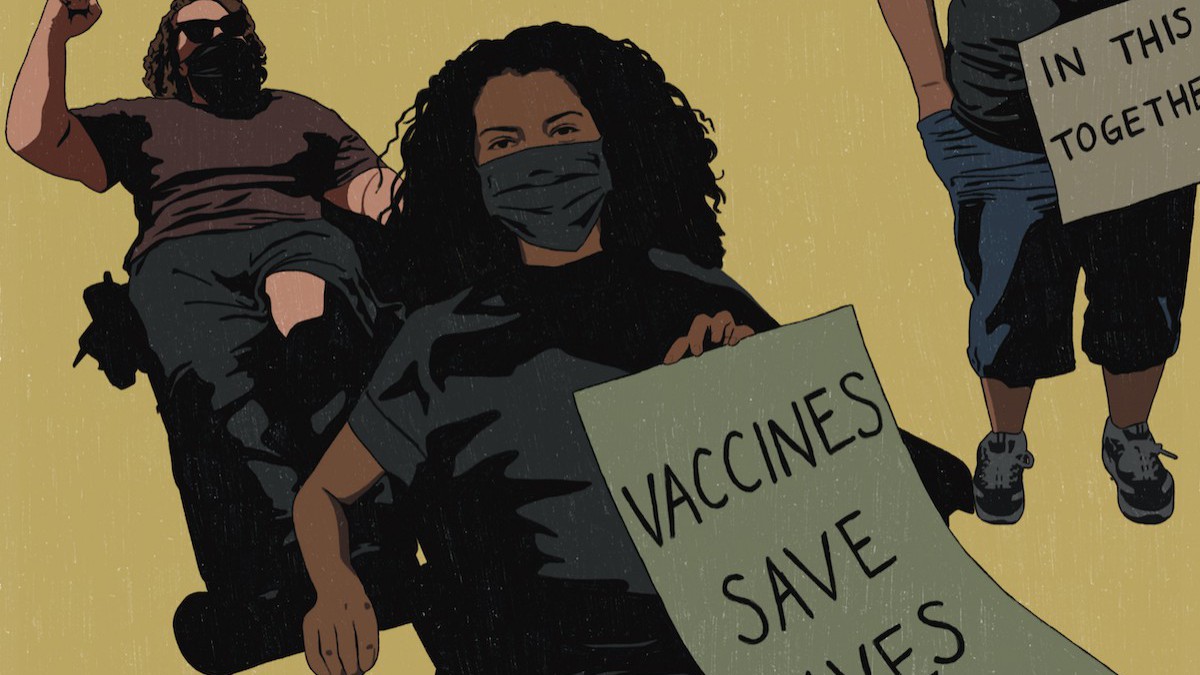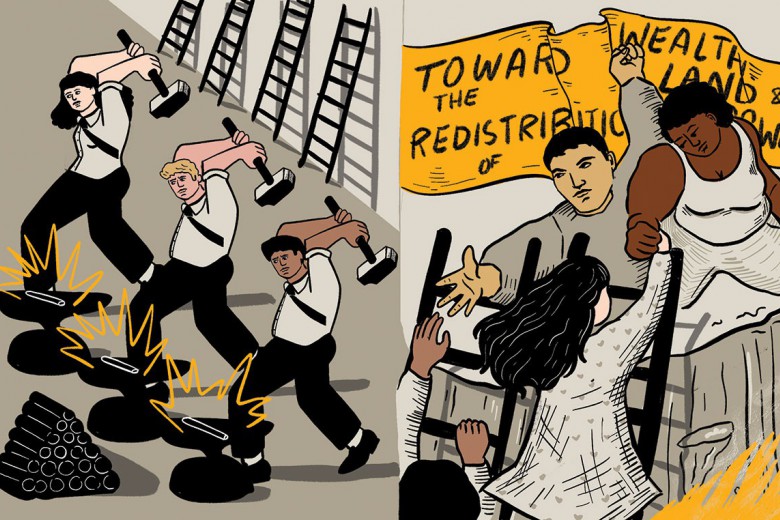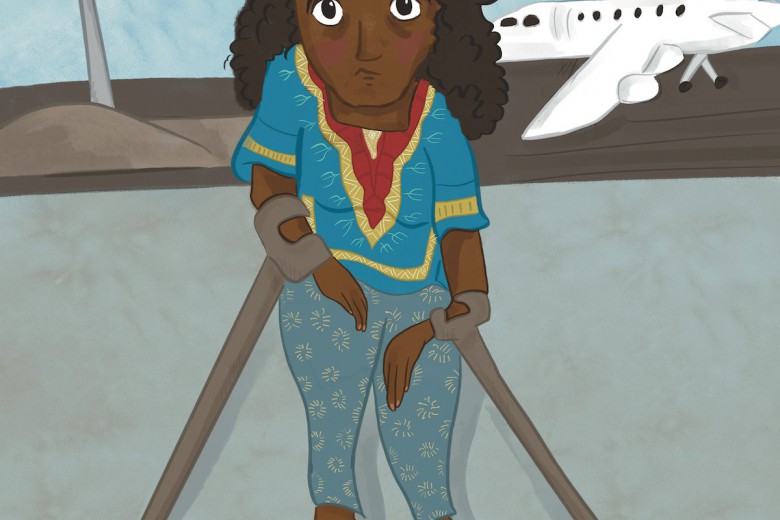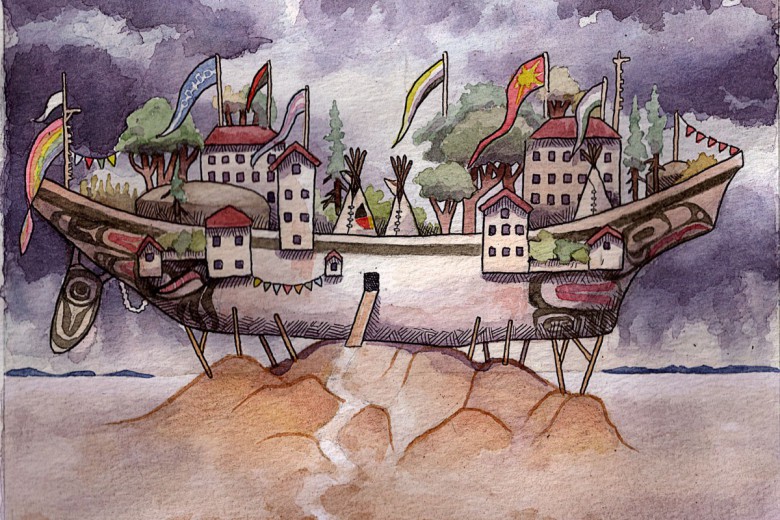Plain language summary (What is this?)
- In January and February of 2022, hundreds of people calling themselves the “Freedom Convoy” came to Ottawa to protest public health COVID protections like masks and vaccine mandates.
- The Freedom Convoy caused an uproar when some of the people involved defaced a statue of Terry Fox.
- Fox was a disabled man who raised money to cure cancer in 1980 by running across Canada in an event called the Marathon of Hope.
- We share some of the history of Fox’s run along with some of Canada’s settler colonial and disability history. They explore the connections between the iconography and legacy of Terry Fox, white nationalism, and COVID public health measures.
- We show how violence against Indigenous and disabled people lies beneath calls for Canadian unity, and we ask people to challenge ableism in all its complex forms.
“Mandate Freedom,” read the placard placed in the arms of Terry Fox. The bronze statue stands across the street from Parliament Hill in Ottawa, on the unceded and unsurrendered territory of the Algonquin Anishinabeg. On January 29, 2022, as hundreds of Freedom Convoy participants and far-right supporters descended upon downtown Ottawa, some tied a Canadian flag around the neck of Fox’s statue like a cape, placed a hockey hat on his head, and rested a pole holding an upside-down Canadian flag against his chest.
This isn’t the first instance of Fox’s iconography being mobilized by Freedom Convoyers. Almost a year earlier on April 27, 2021, at Hillcrest Park in Thunder Bay, Ontario, Chris “Sky” Saccoccia, an organizer leading the first Freedom Convoy across Canada from Vancouver, was arrested for disregarding Ontario’s provincial emergency orders as he stood in front of the Terry Fox National Monument and spoke against public health measures to a crowd of supporters. Pointing to Fox’s statue, Saccoccia said, “Like [Fox], our Freedom Convoy is made up of Canadians who have been travelling across the country to raise awareness for an even greater cause.” Saccoccia vowed to “pick up the torch for Terry and keep going” to end COVID-19 public health measures.
On social media, supporters of the Freedom Convoy frequently invoked Fox’s 1980 Marathon of Hope as a time when, as one Twitter user put it, “Canadian’s [sic] all came together.” Another tweeted: “My kids are watching the truckers[’] convoy much like I watched the Terry Fox or Olympic Torch run when I was their age. I still remember the excitement … and freezing toes. [Canada] can be so beautiful.”
Fox, a single-leg amputee who died of cancer in 1981 at the age of 22, became one of Canada’s most iconic figures after he launched a cross-Canada marathon to fundraise for cancer research. Starting on April 12, 1980, in St. John’s, Newfoundland, Fox ran an average of 42 kilometres per day for 143 days, covering 5,373 kilometres before the return of his cancer cut short his ability to continue just outside of Thunder Bay. He died the following year.
As two disabled scholars who study disability, we think it’s worth pausing to consider why the icons of Fox resonate with a particular form of Canadian right-wing eugenic white nationalism.
As the Freedom Convoy readily claimed Fox, others were quick to denounce the “appropriation” of Fox’s legacy and their “defacement” of the Ottawa statue. Brad West, mayor of Port Coquitlam, Fox’s hometown, tweeted that Fox is “our city’s hero, national inspiration and [a] unifier. Whatever your cause, you don’t get to appropriate his legacy and you don’t touch his statue. Ever.” A Global News reporter tweeted in agreement, “Some lines you don’t cross,” while others sought to turn their “disappointment” with the statue’s modification into “something positive” by donating to the Terry Fox Foundation. The foundation welcomed the donations, tweeting that “Terry believed in science and gave his life to help others. We are grateful for our supporters who help us work toward realizing Terry’s dream of a world without cancer.”
To some, the Convoy had no business appropriating Fox’s statues. But, as two disabled scholars who study disability, we think it’s worth pausing to consider why the icons of Fox resonate with a particular form of Canadian right-wing eugenic white nationalism. This isn’t to say that Terry Fox himself was a right-wing, eugenic, white nationalist who would have supported the Convoy – there’s a difference between a person and their iconography, between who Fox was and what he represents. Fox is possibly the most famous disabled icon in the country. His image has been featured on a stamp and a coin, and schools, roads, highways, public buildings, and even a mountain have been named after him. Likewise, the Marathon of Hope is one of the most readily understood forms of disability advocacy in the country. As then-prime minister Pierre Elliott Trudeau said in 1981, “It occurs very rarely in the life of a nation that the courageous spirit of one person unites all people.” The question is, what kind of unity does Fox’s iconography and the Marathon of Hope represent and what does this mean for disability justice politics in so-called Canada?
Selling eugenic nationalism
Charitable marathons, like Fox’s Marathon of Hope, have their roots in what disability studies scholar Alison Kafer calls the “curative imaginary,” the ubiquitous ableist desire that we should eliminate disability through technological and scientific innovation, indicating that a future without disability is a future we all should want. Queercrip artist and organizer Kevin Gotkin notes that charitable marathons, telethons, walkathons, and other types of “-thons” rely on “a powerful ideal of ability,” “collective desires for normalcy,” and the promise of biomedical innovation to charitably cure the sick and disabled body. For Gotkin, marathons are embedded with cultural aspirations about “what it means to be healthy, normal, and active participants in society” in ways that shore up and maintain ableism.
What is considered to be a “social ill” that must be overcome is political. In early settler-colonial Canadian history, “social ill” often took the form of labelling disabled, Indigenous, and racialized people as unproductive degenerates, which materialized as racist and ableist immigration bans, widespread institutionalization, and forced sterilization. Canadian laws, such as Alberta’s “An Act respecting Mentally Incompetent Persons and their Estates, 1937,” allowed the state to confiscate property and personal assets in order to pay for the cost of institutionalization, further incentivizing the practice. Due to the vast overrepresentation of Indigenous people targeted through such acts, this contributed to the profitable confiscation and destruction of Indigenous lands.
This isn’t to say that Terry Fox himself was a right-wing, eugenic, white nationalist who would have supported the Convoy – there’s a difference between a person and their iconography, between who Fox was and what he represents.
Eugenic practices, entwined with capitalist and settler-colonial aims, were sold by governments to the public through nationalist discourses of protecting the superior “Aryan character of the future of British America” (in the words of John A. Macdonald) and, later, to serve and save the more evolved, white “Canadian Race” (in the words of Nellie McClung). Eugenics was also sold under the banner of democratic freedom. Helen MacMurchy, Canada’s first chief of the Division of Maternal and Child Welfare for the federal Department of Health, wrote, “It is the age of true democracy that will not only give every one justice, but will redeem the waste products of humanity.” This “redemption,” according to MacMurchy, meant barring those deemed undesirable from immigrating and having children. Using discourses of public health, MacMurchy argued that degenerates’ “personal inadequacies underlay much of the ill health of the nation” and nearly all of the nation’s physical and social ills. In this way, Canadian public health has never been about protecting the lives of people made vulnerable, but rather about protecting the nation from those same people, along with the anti-capitalist and anti-colonial interventions that would be needed to enable their flourishing.
With the advent of neoliberalism and liberal forms of tolerance, such explicit eugenic statements like MacMurchy’s became less socially acceptable. But eugenicist forms of curing social ills have continued unabated, just a little less explicitly. The threshold of public health “protections” across Canada have been consistently – and eugenically – below the threshold of protecting those made most vulnerable to COVID. Instead, they have been designed to serve capitalist productivity rationales and to secure the well-being of what MacMurchy called “The Canadian National Stock.” As the number of adults and children infected by COVID-19 in Ontario skyrocketed to over 100,000 infections per day in April 2022, then-Ontario minister of health Christine Elliott told reporters that an uptick in cases is “something that we anticipated with the opening up of Ontario to get us back to our economic strengths.”
Branding Fox’s legacy
Cancer philanthropy is big business and has a long history of cross-promotions with large corporations (some of which create products that cause cancer) in ways that maximize revenues. The Marathon of Hope raised $1.7 million during Fox’s run and $24.17 million before his death, meeting Fox’s goal of raising $1 per Canadian. Since 1980, the Fox Foundation has gone on to raise $850 million.
Fox’s actions and image have been mobilized to maximize fundraising revenue, but one of the most compelling things about Fox was his adamant refusal to engage in corporate sponsorship. Fox refused to wear any logos or engage with any cross-marketing schemes, arguing that no one should profit off of cancer. But his stance was bad for business. Fox received minimal media attention, donations, or fanfare for the first few months of his journey. As Fox ran through Quebec, his fundraising dried up even more, a problem not helped by his very vocal, far from politically neutral disdain for Québécois culture, language, and particularly the separatist movement. Once Fox crossed the border into Ontario, however, this all changed. Cancer fundraiser Bill Vigars mobilized Fox’s vocal disdain for Quebec – and many photo ops with famous Canadian hockey stars and their jerseys – to market Fox, and his journey, as unifying a threatened country. Fox was the ideal logo for this branding: a young, white-passing, middle-class man with a map of Canada and a Canadian flag on his shirt. In a time of vocal Quebec sovereignty movements, rife anti-Quebec and anti-immigrant sentiment, and increasing Indigenous sovereignty protests and court battles, Fox came to symbolize a certain kind of “Canadian unity” that white Ontarians and Western Canadians could get behind. Fox’s promised route, starting mere miles from where the British first settled in Newfoundland and heading against the wind toward Vancouver’s shores, invoked ideas of Canadian discovery, romanticizing early exploration and survival against all odds. As Douglas Coupland explains, “Perhaps Terry was born with an innate need to go West – a bit of the Canadian pioneer spirit.” Most images of the Marathon of Hope were not of Fox running through the major cities purposely threaded through the route to maximize fundraising capacity, but rather of Fox running through punishing weather against the backdrop of vast, wild, and (seemingly) uninhabited natural expanses. These images resonate with two of Canada’s violent foundational myths: that this land was an empty terra nullius when colonizers descended and that settlers earned their place here due their superior white grit and determination.
“Perhaps Terry was born with an innate need to go West – a bit of the Canadian pioneer spirit.”
This context helps explain why the “defacement” of Fox’s statue was so different from the defacement and removal of statues of colonizers like Egerton Ryerson and Queen Victoria, both of which were toppled by anti-colonial protesters in 2021. Rather than an act of critique or denunciation, the Freedom Convoy glorified and leveraged Fox’s legacy. Indeed, the Convoy’s posthumous adornment of Fox echoes precisely how cancer marketers adorned Fox throughout his time in Ontario, by draping him in two of the most white, Canadian national symbols: hockey paraphernalia and Canadian flags.
Given Fox’s outspoken opposition to Quebec separatism, he likely would have taken issue with the prominent role of Western separatists in the movement. Further, although Fox likely had no idea of his non-European roots while he was alive, his family’s reclaimed Métis heritage makes Fox a complicated brand affiliation for a group harbouring known white supremacists. Most directly in conflict, however, was Fox’s explicit goal to save the lives of people with cancer. This aim is in direct opposition to those explicitly espoused by the Freedom Convoy. In a moment when minimal public health measures have caused the mass death and debilitation of disabled, racialized, and poor people, the Convoy called to eliminate Canada’s remaining public health measures like mandatory masks and vaccines. The end of these measures poses an immense threat to the lives of those with cancer or living in its aftermath, because cancer treatments often negatively impact the immune system. Still, while Fox himself may not have supported the Convoy, he, as a branded icon, was used to maximize fundraising revenue and sell Canadian nationalism, making him a useful tool to support fundraising by the Convoy, especially from the white nationalist portion of its base.
Disability justice against charity
In a country where increasingly impoverished and houseless disabled people are only supported through spare change, charities for cures, or Medical Assistance in Dying (MAiD), it is little wonder that the Freedom Convoy claims Fox as an icon of the kind of Canadian unity they seek to build. Fox as an icon of hope, grit, and independence leads Canadians to feel, as disability studies scholar Sally Chivers comments, “more tied to an ideal Canadianness even though, in fact, disabled Canadians face innumerable barriers to social inclusion.” As our brief history shows, instead of supporting disabled people through accessible, affordable housing, well-funded personal care workers, easy access to assistive devices and accessible transportation, and robustly funded public health care and medical research, Canadians are instead united in their rejection of disability, continuing a long history that overwhelmingly eliminates, disappears, and disposes of disabled people through cure, institutionalization, or MAiD.
Challenging the Freedom Convoy means challenging Canadianness down to its racist, eugenic, colonial core. Anti-eugenic practices that aim to keep marginalized populations safe, such as vaccinations and wearing masks, can be understood as essentially unCanadian. Doing “something positive” in response to the Convoy’s appropriation of Fox’s iconography isn’t best achieved by making a charitable donation to the Terry Fox Foundation, but rather in joining disabled people across the country to fight ableism in all its complex forms – including the ways racism, colonialism, ableism, and charity buttress each other. That is a kind of unity we can be hopeful about.







